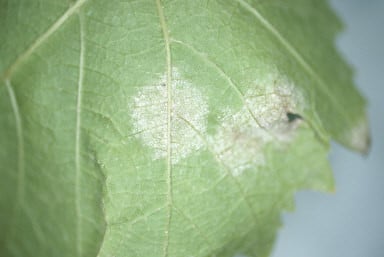
Quick facts
Common name - Downy mildew
Scientific name - Various, mainly species of Peronospora, Plasmopara and Bremia
Plants affected - Many ornamental and edible plants, including brassicas, columbine, Impatiens, grapevines, lettuces, onions, peas, pansies, tobacco plants
Main symptoms - Discoloured areas on upper leaf surfaces; white, grey or purple mould below
Caused by - Fungus-like (Oomycete) organisms
Timing - Mainly summer and autumn, particularly in wet conditions
What is downy mildew?
Downy mildew is a disease of the foliage, caused by a fungus-like (Oomycete) organism. It is spread from plant to plant by airborne spores. It is a disease of wet weather as infection is favoured by prolonged leaf wetness.
A range of common edible and ornamental plants can be affected, including brassicas, carrots, columbine (Aquilegia), foxgloves, geum, grapevines, Veronica (Hebe), busy Lizzie (Impatiens), lettuces, onions, pansies, parsnips, peas, poppies, rhubarb, roses, spinach and tobacco plants (Nicotiana).
Click on the links above to go to profiles of the disease on some of the common host plants.
Downy mildews usually have narrow host ranges comprising of just a few related plants. For example, the downy mildew affecting brassicas is a different species from the one attacking pansies.
Symptoms
Take a look at the photo gallery below for pictures of symptoms on different host plants.
Unlike powdery mildews, plants affected by downy mildew are not so easy to recognise. Look out for the following:
- Discoloured blotches on the upper leaf surface. These may be pale green, yellow, purple or brown, depending on the plant affected. The blotches sometimes have straight edges (e.g. on lettuce) if they are bordered by the leaf veins
- A mould-like growth on the underside of the leaf, corresponding to the blotch on the upper surface. This growth may be white, grey or purple, depending on the species of downy mildew
- On some plants (e.g. pea, pansy) the growth is easy to see with the naked eye. On others (e.g. foxglove, rose) it can be difficult to see, even with a hand lens
- Severely affected leaves may shrivel and turn brown (e.g. tobacco plant), or turn yellow and fall prematurely (e.g. Impatiens, rose)
- Occasionally, other plant parts can be affected, e.g. cauliflower curds, Impatiens flower , pea pods
- Severely affected plants are often stunted and lack vigour. In some cases (e.g. columbine,Impatiens, tobacco plant) the plant may die

Control
Non-chemical control
- Pick off and dispose of (by deep burial, burning or consigning to the council ) affected leaves as soon as symptoms are seen
- Remove and destroy severely affected plants
- Avoid dense planting and control weeds, so that there is good air circulation around the plants
- In glasshouses, try to avoid prolonged leaf wetness or periods of high . Avoid overhead watering where possible. Open the doors and vents, when conditions allow, encouraging air movement
- Avoid watering plants in the evening, as this can lead to high humidity or leaf wetness that persists throughout the night. Water early in the morning so that leaf surfaces dry out rapidly
- To avoid infection from soil-borne resting spores, practice crop rotation for vegetables, and avoid re-planting with the same host for at least a year where an ornamental plant has been affected
Resistance: Cultivars with resistance to downy mildew are available for some vegetable crops, such as lettuce and onions, and a limited number of resistant Impatiens cultivars have recently become available . Check the latest catalogues for information on the cultivars available. However, in some cases the disease resistance can break down if the downy mildew mutates to produce a different ‘race’, so growing a resistant does not always guarantee freedom from infection. The situation with lettuce downy mildew is particularly complex as there are many different races, with new ones emerging all the time. Spinach is similar in this respect.
Chemical control
There are no fungicides available to amateur gardeners for use against downy mildews.
Biology
Downy mildews are caused by microscopic, fungus-like (Oomycete) organisms. Despite a similar name and certain similarities in symptoms, they are unrelated to the powdery mildews.
The disease is spread by spores produced on the underside of infected leaves. These spores are splashed by rain, and are also sometimes carried for long distances on the wind.
Extended periods of leaf wetness are required for infection, so severe outbreaks of downy mildew are only likely to occur outdoors during wet summers. Where plants such as lettuces are grown in glasshouses, the disease may be present throughout the year and can cause major problems in spring and autumn, as it is very difficult to control and leaf wetness at these times.
Many downy mildews produce their spores at night, and extended periods of high humidity or leaf wetness overnight can lead to severe outbreaks.
The airborne spores remain viable for just a short time, but most downy mildews also produce a second spore type (a resting spore known as an oospore) within the affected plant tissues. These resting spores are much more resilient. They are released into the soil as the diseased material rots down, and are likely to survive for an extended period (up to five years). If the host plant is grown again in contaminated soil while the resting spores are still viable, they may infect it through the roots to cause a systemic infection (one that spreads throughout the plant).















